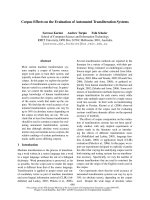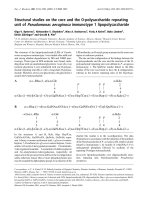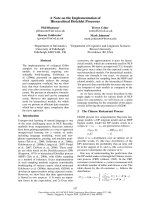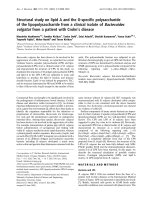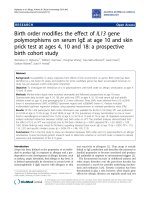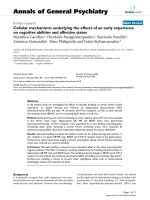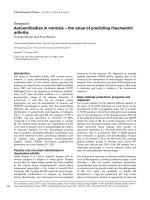Báo cáo y học: " Myocardial infarction on the ICU: can we do better" doc
Bạn đang xem bản rút gọn của tài liệu. Xem và tải ngay bản đầy đủ của tài liệu tại đây (40.01 KB, 2 trang )
Page 1 of 2
(page number not for citation purposes)
Available online />Abstract
Myocardial infarction remains a major cause of death despite
contemporary therapeutic strategies. Diagnosis in the intensive care
unit is challenging, but is essential to target therapy accurately. In this
issue of Critical Care Lim and colleagues present the results of a
prospective non-interventional screening study for acute myocardial
infarction in patients admitted to the intensive care unit. Myocardial
infarction is observed to occur frequently, often without being
clinically apparent, with a high associated mortality. Such
approaches may facilitate accurate diagnosis of myocardial infarction
in this setting, hence opening the way to improved therapy.
Myocardial infarction (MI) in the critically ill presents a
diagnostic challenge to the physician and is associated with a
particularly adverse outcome for the patient [1]. Such
patients have high metabolic demands and are often subject
to sustained adverse physiology. Typical signs and symptoms
can be difficult to elicit and surrogate physiological markers
of impaired coronary perfusion masked or misinterpreted in
the context of the index pathology. Cardiac troponin measure-
ments and the 12-lead echocardiogram (ECG) remain
sensitive in this setting, but specificity decreases, resulting in
diagnostic uncertainty.
Recent consensus guidelines from the European Society of
Cardiology, American College of Cardiology Foundation,
American Heart Association and World Heart Federation
emphasise the role of cardiac biomarkers in defining MI [2].
Diagnosis requires a rise and/or fall in serum levels
(preferably troponin) together with evidence of myocardial
ischaemia defined: clinically by patient history; electro-
cardiographically (new ST-T wave changes, new left bundle
branch block or evolving pathological Q waves); or by
imaging evidence of new regional wall motion abnormality.
Current troponin assays provide a highly sensitive marker of
even microscopic levels of myocardial necrosis [3]. This does
not define the mechanism of injury, however, and troponin
elevation is reported in a variety of non-acute coronary
syndrome (non-ACS) pathologies common in the intensive
care unit (ICU), including pulmonary embolus, severe sepsis
and renal impairment [4,5]. All-cause mortality and duration of
ICU admission are increased in critically ill patients with
elevated troponin, irrespective of the cause. Lim and
colleagues [6] have previously reported on a meta-analysis of
20 studies with 3,278 general ICU patients, where the
median incidence of troponin-positivity was 43%. This was
associated in an adjusted analysis of 6 of these studies
(1,706 patients) with a significant increase in mortality (odds
ratio of dying 2.5, 95% confidence interval (CI) 1.9 to 3.4;
p < 0.001), and in a further unadjusted analysis of 8 of these
studies (1,019 patients) with an increase in ICU stay (3 days,
95% CI 1 to 5.1, p = 0.004) and a trend towards longer
overall hospital admission (2.2 days, 95% CI -0.6 to 4.9;
p = 0.12). Whether the adverse outcome was due to conco-
mitant ACS, or the severity of the index condition, resulting in
troponin elevation, is a critical question in targeting appro-
priate therapies.
The problems of troponin specificity dictate the requirement
for additional diagnostic criteria in defining MI, and nowhere
is this more true than on the ICU. Clearly, treatment strategies
appropriate for ACS may not improve outcome where
elevated troponin is due to an alternative pathology.
Myocardial ischaemia in the setting of mechanical ventilation
and weaning is well described [7,8]. Contemporary analyses
of ICU patients with current definitions of myocardial
infarction are limited. Booker and colleagues [9] prospec-
tively screened 76 consecutive patients admitted to a general
ICU. ST-segment changes on continuous telemetry and
12-lead ECGs for the first 24 to 48 hours of admission were
recorded with troponin I (TnI) assays 8 to 12 hours after
monitoring. There were 37 ECG-defined ischaemic events
detected in 8 patients (10.5%), of which 96% were
Commentary
Myocardial infarction on the ICU: can we do better?
Ian Webb and James Coutts
Department of Cardiology, St Thomas’ Hospital, Guys and St Thomas’ NHS Foundation Trust, London, SE1 7EH, UK
Corresponding author: James Coutts,
Published: 3 April 2008 Critical Care 2008, 12:129 (doi:10.1186/cc6832)
This article is online at />© 2008 BioMed Central Ltd
See related research by Lim et al., />ACS = acute coronary syndrome; CI = confidence interval; ECG = echocardiogram; ICU = intensive care unit; MI = myocardial infarction.
Page 2 of 2
(page number not for citation purposes)
Critical Care Vol 12 No 2 Webb and Coutts
asymptomatic. Out of the 8 patients, 6 had significant
troponin I elevation, and this accounted for 50% of all
troponin-positive results. More recently, Lim et al. [1] reported
on the combined results of ECG, troponin testing and new
regional wall motion defects on echocardiography in general
ICU patients. Investigations were clinically driven, but of 93
patients included, 24 (25.8%) were diagnosed with
coincident MI, and this was associated with a significantly
higher ICU (37.5% versus 17.6%; p = 0.05) and in-hospital
(50% versus 22%; p = 0.01) mortality, even after correction
for APACHE II score and inotrope/vasopressor requirement.
The current paper by Lim and colleagues [10] continues a
series of publications from the McMaster group analysing MI
and the diagnostic components in the critically ill patient. A
robust screening protocol for MI was devised, defined
according to consensus-guidelines by the presence of
positive troponin assay and ischaemic ST-T wave changes on
ECG. The study includes 103 patients admitted to general
ICU and enrolled over a two month period. Serial 12-lead
ECGs and cardiac troponin T (cTnT) assays were performed.
Tests were performed additionally, and blinded to ICU staff, if
not ordered on clinical grounds. Only one patient had an
index diagnosis of MI.
Patients were analysed according to: diagnosis of MI (35.9%
of patients); presence of positive troponin only (14.6%); and
troponin-negative status (49.5%). ICU staff made a clinical
diagnosis of MI in 18 patients (17.5%), although 4 did not
fulfil diagnostic criteria. Screening identified an additional 23
patients with true infarction. MI was associated with a longer
ICU stay (median 5 versus 2 days; p = 0.001) and increased
hospital mortality (43.2% versus 2%; p < 0.0001) compared
to troponin-negative patients. MI patients also required a
longer period of mechanical ventilation (median 4 days versus
2 versus 1; p < 0.0001) with increased ICU mortality (37.8%
versus 6.7% versus 2.0%; p < 0.0001) compared to the
troponin positive and negative groups, respectively.
This paper supports existing literature regarding adverse
outcomes for ICU patients with coincident MI, and impor-
tantly highlights the additional detection rate afforded by
simple screening investigations. Whether this will translate
into better patient outcomes through targeted therapy -
pharmacological and interventional - will surely be the subject
of future studies. Interestingly, in the current paper, mortality
rates were similar for MI patients irrespective of whether this
was diagnosed prospectively by ICU staff or not. Indeed,
there was actually a trend towards better outcome in those
not identified, which one would speculate reflects a less
unwell subset of patients with smaller infarcts (rather than any
iatrogenic effect).
Invasive strategies (coronary angiography and percutaneous
intervention) have a clear role in the patient with ACS outside
of the ICU. Their role in the ICU setting is less clear -
although the potential benefits are very high, so are the risks.
Interventional approaches in this population are beset with
difficulties arising from the lack of specificity of troponin
elevation, and the difficulty in early diagnosis of MI. The work
of Lim and colleagues [10] provides further clarification as to
which patients could be targeted; further studies are required
to ascertain the way in which this should be undertaken.
Competing interests
The authors declare that they have no competing interests.
References
1. Lim W, Qushmaq I, Cook DJ, Crowther MA, Heels-Ansdell D,
Devereaux PJ: Elevated troponin and myocardial infarction in
the intensive care unit: a prospective study. Crit Care 2005, 9:
R636-R644.
2. Thygesen K, Alpert JS, White HD, Jaffe AS, Apple FS, Galvani M,
Katus HA, Newby LK, Ravkilde J, Chaitman B, Clemmensen PM,
Dellborg M, Hod H, Porela P, Underwood R, Bax JJ, Beller GA,
Bonow R, Van der Wall EE, Bassand JP, Wijns W, Ferguson TB,
Steg PG, Uretsky BF, Williams DO, Armstrong PW, Antman EM,
Fox KA, Hamm CW, Ohman EM, et al.: Universal definition of
myocardial infarction. Circulation 2007, 116:2634-2653.
3. Jaffe AS, Ravkilde J, Roberts R, Naslund U, Apple FS, Galvani M,
Katus H: It’s time for a change to a troponin standard. Circula-
tion 2000, 102:1216-1220.
4. Ammann P, Maggiorini M, Bertel O, Haenseler E, Joller-Jemelka
HI, Oechslin E, Minder EI, Rickli H, Fehr T: Troponin as a risk
factor for mortality in critically ill patients without acute coro-
nary syndromes. J Am Coll Cardiol 2003, 41:2004-2009.
5. Jeremias A, Gibson CM: Narrative review: alternative causes
for elevated cardiac troponin levels when acute coronary syn-
dromes are excluded. Ann Intern Med 2005, 142:786-791.
6. Lim W, Qushmaq I, Devereaux PJ, Heels-Ansdell D, Lauzier F,
Ismaila AS, Crowther MA, Cook DJ: Elevated cardiac troponin
measurements in critically ill patients. Arch Intern Med 2006,
166:2446-2454.
7. Hurford WE, Lynch KE, Strauss HW, Lowenstein E, Zapol WM:
Myocardial perfusion as assessed by thallium-201 scintigra-
phy during the discontinuation of mechanical ventilation in
ventilator-dependent patients. Anesthesiology 1991, 74:1007-
1016.
8. Hurford WE, Favorito F: Association of myocardial ischemia
with failure to wean from mechanical ventilation. Crit Care
Med 1995, 23:1475-1480.
9. Booker KJ, Holm K, Drew BJ, Lanuza DM, Hicks FD, Carrigan T,
Wright M, Moran J: Frequency and outcomes of transient
myocardial ischemia in critically ill adults admitted for noncar-
diac conditions. Am J Crit Care 2003, 12:508-516.
10. Lim W, Holinski P, Devereaux PJ, Tkaczyk A, McDonald E, Clarke
F, Qushmaq I, Terrenato I, Schunemann H, Crowther M, Cook D:
Detecting myocardial infarction in critical illness using screen-
ing troponin measurements and ECG recordings. Crit Care
2008, 12:R36.


